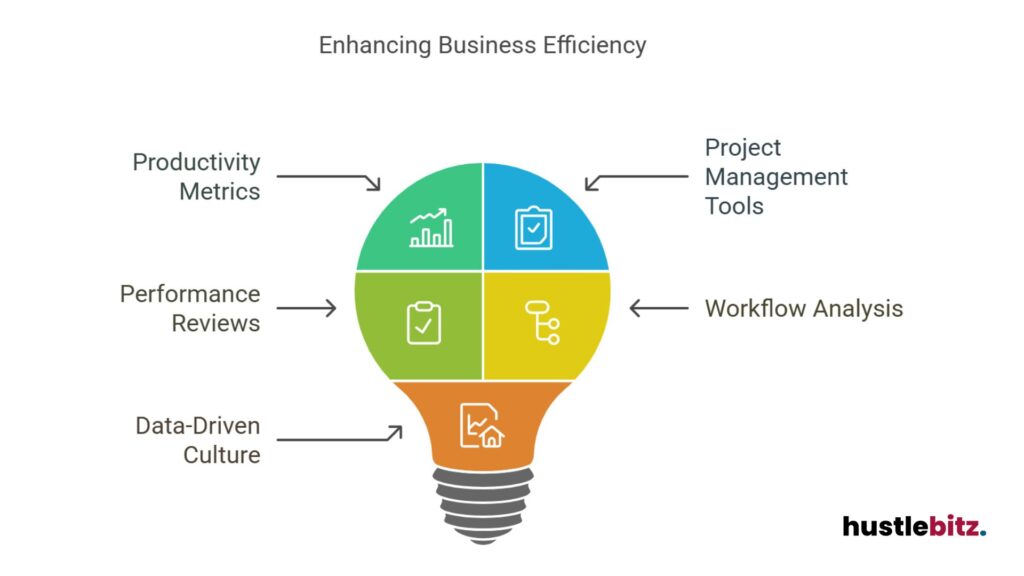To measure productivity levels in your business, focus on key metrics such as output per labor hour and sales per employee. Implement tools like project management software and time-tracking applications to gather data effectively. Regular performance reviews provide insights into employee contributions and operational efficiency. Additionally, analyzing workflows can help identify bottlenecks that hinder productivity. A data-driven approach enables informed decision-making and resource allocation aligned with business objectives. Cultivating a culture of continuous improvement and accountability is essential for sustained productivity growth. Exploring these methods further can uncover additional strategies for enhancing your business’s efficiency.
Key Takeaways
- Define productivity metrics such as output per hour and sales per employee to assess efficiency.
- Utilize project management software and time-tracking applications for effective task and time management.
- Conduct regular performance reviews to establish benchmarks and identify areas for improvement.
- Analyze workflows to identify bottlenecks and address inefficiencies in operations.
- Foster a data-driven culture to promote continuous improvement and informed decision-making.

Defining Productivity in Business
In the context of business, productivity is defined as the efficiency with which an organization converts inputs—such as labor, materials, and capital—into outputs, typically measured in terms of goods or services produced within a specific time frame. Understanding productivity is crucial for any organization aiming to enhance its performance and remain competitive in a rapidly evolving marketplace.
A clear measure of productivity helps in assessing how effectively resources are utilized to generate results. For instance, productivity in a company can be evaluated through various metrics, such as output per labor hour, sales per employee, or overall return on investment. These metrics not only highlight areas of strength but also identify opportunities for improvement.
Employee productivity plays a vital role in determining the overall productivity of a company. When employees are engaged and equipped with the right tools, their output significantly contributes to the organization’s success. Conversely, low employee productivity can hinder growth and profitability.
Therefore, organizations must regularly assess and measure productivity levels to ensure they are on track to meet their goals.
Key Metrics for Measurement

Several key metrics serve as essential tools for measuring productivity levels within a business, enabling organizations to evaluate performance and identify areas for improvement. By implementing these metrics, companies can effectively measure productivity in the workplace and gain insights into employee performance.
To successfully measure employee productivity, the following productivity metrics are commonly utilized:
- Output per Hour: This metric quantifies the total output generated by an employee within a specified time frame, providing a clear view of productivity levels.
- Sales per Employee: This measures the revenue generated per employee, helping organizations assess overall efficiency and effectiveness in generating income.
- Task Completion Rate: Evaluating the percentage of tasks completed within a given period can provide insights into workflow efficiency and bottlenecks.
- Employee Utilization Rate: This metric assesses the proportion of time employees spend on productive tasks versus non-productive activities, allowing for targeted improvements.
- Customer Satisfaction Scores: Understanding how satisfied customers are with products or services can serve as an indirect measure of productivity, as happy customers often correlate with efficient processes.

Engaging in comprehensive productivity analysis using these metrics allows businesses to pinpoint areas needing enhancement while measuring productivity changes over time. By continually monitoring these key indicators, organizations can adapt strategies that foster growth and efficiency, ultimately leading to improved overall performance.
Tools for Tracking Productivity

Effective tools for tracking productivity play a crucial role in helping businesses monitor employee performance and streamline operations. By employing the right tools, organizations can effectively measure productivity and identify areas for improvement. Various software solutions and applications are designed specifically to facilitate productivity tracking, making them invaluable assets in today’s competitive landscape.
One popular category of tools for tracking productivity includes project management software like Trello, Asana, and Monday.com. These platforms allow teams to assign tasks, set deadlines, and visualize progress, which aids in monitoring productivity at both individual and team levels.
Another effective method of measuring productivity is through time-tracking applications such as Toggl or Clockify. These tools help employees log their hours and provide insights into how time is spent throughout the workday.
In addition to software solutions, businesses can adopt productivity measurement strategies such as employee surveys and performance reviews. These qualitative methods complement quantitative data gathered through tracking tools, offering a holistic view of productivity levels.
Furthermore, implementing key performance indicators (KPIs) can enhance monitoring productivity by establishing clear benchmarks against which performance can be assessed.
Implementing Regular Reviews

How can implementing regular reviews enhance a business’s understanding of productivity and foster continuous improvement?
Regular reviews serve as a vital component in measuring productivity levels within an organization. They provide structured opportunities to assess how effectively employees work, enabling businesses to track productivity and identify areas for enhancement.
Through consistent evaluations, management can gain valuable insights into various aspects of performance.
Here are five key benefits of implementing regular reviews:
- Enhanced Feedback Mechanism: Regular reviews encourage open dialogue between employees and management, allowing for constructive feedback and collaborative goal setting.
- Clear Performance Metrics: Establishing benchmarks during reviews helps in understanding how to measure productivity accurately, ensuring that everyone is aligned with organizational objectives.
- Early Detection of Issues: Frequent assessments allow businesses to identify potential challenges before they escalate, facilitating timely interventions.
- Employee Engagement: Involving employees in the review process fosters a sense of ownership and accountability, motivating them to improve their productivity levels.
- Strategic Planning: Regular reviews provide essential data that informs strategic decisions, ensuring that resources are allocated effectively to enhance productivity.

Identifying Bottlenecks and Challenges

Identifying bottlenecks and challenges within a business is crucial for optimizing productivity and ensuring smooth operational flow. Bottlenecks can arise from various sources, including inefficient processes, inadequate resources, or communication breakdowns. By recognizing these areas of strain, businesses can take proactive measures to enhance their overall operations.
A fundamental aspect of productivity measurement involves analyzing workflows and identifying bottlenecks that hinder progress. This analysis enables organizations to pinpoint specific challenges in productivity, such as delayed approvals or resource shortages. Once these challenges are identified, teams can develop targeted strategies to address them, thereby streamlining operations.
Moreover, productivity can help you identify patterns that contribute to ongoing challenges. For instance, regular monitoring of performance metrics can reveal trends that indicate when and where bottlenecks frequently occur. By understanding these trends, businesses can implement changes that not only resolve immediate issues but also prevent future occurrences.
Additionally, measuring progress against established benchmarks allows for a clearer understanding of productivity levels. This evaluation not only aids in recognizing current bottlenecks but also highlights areas for improvement. By fostering a culture of continuous improvement, organizations can enhance their workflow and ultimately achieve higher productivity levels.
Making Data-Driven Decisions
Recognizing bottlenecks and challenges sets the stage for making data-driven decisions that can significantly enhance productivity and operational efficiency. By employing effective productivity measuring methods, businesses can gain insights that are crucial for strategic planning and improvement.
Understanding how to measure employee productivity accurately allows organizations to track how productivity fluctuates over time, enabling them to identify areas requiring attention.
To make informed decisions, consider the following approaches:
- Data Analytics: Utilize tools to analyze performance metrics and uncover trends.
- Employee Feedback: Regularly gather insights from staff to understand challenges they face.
- Benchmarking: Compare productivity levels with industry standards to identify gaps.
- Goal Setting: Implement SMART goals to provide clear targets for improvement.
- Performance Reviews: Conduct systematic evaluations to measure employee contributions.
These methods not only help in tracking how productivity changes but also facilitate strategies to increase productivity effectively.
A successful business must leverage data to make informed decisions that drive performance and engagement. By fostering a culture of data-driven decision-making, companies can adapt swiftly to changing conditions and better align resources to meet their goals.
Ultimately, these practices contribute to a sustainable competitive advantage in today’s dynamic market landscape.
Final Thoughts
Effectively measuring productivity levels is crucial for optimizing your business operations and ensuring sustained growth. By focusing on key metrics such as output per labor hour and sales per employee, and utilizing tools like project management software and time-tracking applications, you can gain valuable insights into performance and efficiency. Regular performance reviews and workflow analyses help identify bottlenecks and challenges, fostering a culture of continuous improvement. Adopting a data-driven approach and making informed decisions based on these insights enables better resource allocation and strategic planning. Embracing these practices will enhance productivity and support the achievement of your business goals.




